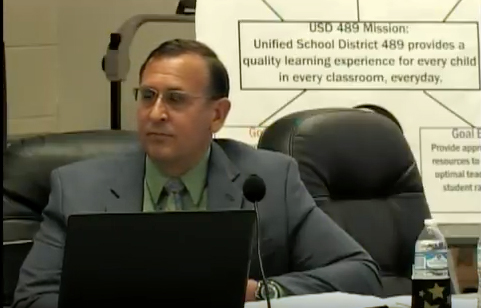By CRISTINA JANNEY
Hays Post
Local educators said they are in a holding pattern after a decision from the Kansas Supreme Court was made earlier this week that the state’s school funding formula is inequitable and inadequate.
A deadline set for June 2018 has school districts across the state in limbo as to what might happen next with state education funding.
“The difficulty here is that there are 284 school districts in the state, and five should not have the power to dictate to everyone else,” Hays USD 489 Superintendent John Thissen said. “Just because something works for them, doesn’t necessarily mean it work for the rest of the other 279.”
Thissen specifically pointed at districts in the Kansas City and Wichita areas.

The Supreme Court looked at the state’s local option budget funding. The LOB allows school districts to levy taxes locally to supplement their budgets. Hays, Ellis and Victoria all have LOBs of 30 percent, which is the maximum available without a vote of the people.
Residents can vote to increase their local option budgets to 33 percent of their state funding.
LOBs were intended to provide extra funding for district-specific projects approved by local school boards. However, in lieu of significant funding cuts, districts had to rely on the LOB funding as a source of revenue for basic school functions.
USD 489 went through a difficult round of staff layoffs during the recession, which Thissen said would have been much worse if it had not been for the LOB.
The problem with the LOB system is that less populated, poorer districts have to levy higher mill levies to raise the same taxes as more populous, more affluent school districts.
Although Victoria’s assessment was up a bit this year, Victoria Superintendent David Ottley said rural western Kansas districts have been hit hard as the valuation of ag and oil land has declined.
Thissen said, “It should not matter if you live in the Blue Valley (district) or Dodge City area, you should still have a fair and equitable amount of finance to educate the kids. There needs to be a formula. There needs to be a plan that is fair for public education. …
“They have do something because it is still not good enough.”
The Legislature approved a two-year school budget during its last session. The late decision on school funding put the state’s schools behind in finishing their budgeting for the 2017-18 school year.
Thissen said because the Supreme Court said the funding level was inadequate, he said he thought the funding levels for 2018-19 would not go down. The district could budget assuming they would have at least as much in 2018-19 as they have this year.
“They said (the formula) needs altered. It is not just a matter of saying there is not enough money. They hinted at that, but they probably put more emphasis on that it is not equitable,” Thissen said. “There are two issue to this — that it is equitable from one district to the next and the other issue is basically having enough money.
“Let’s say that Kansas has a real problem that continues with revenue. We understand that, and that could be a good excuse for not more money, but it is not an excuse for inequities from district to district.”
Ottley said the increase in funding from the Legislature for this school year has made a difference at Victoria schools.
The district was able to open an ag program and FFA chapter, which it has been wanting to do for some time. Teachers were also given raises that had been neglected for several years.
Ottley also said his district has an issue with funding adequacy. Despite raises, the district’s pay for certified and classified staff is still far below their peers. He said the district will take years to fully recover financially from the recession and resulting funding cuts.
“We are a long way from where we need to be for the amount of funding for Victoria or Hays or Ellis to the do things that we need to do to redesign schools to best prepare students for colleges and careers,” he said.
Problems also continue to exist with equity in the funding formula, he said. Victoria has struggled with class size and funding for at-risk programs. The district has goals to increase technical education and college preparation.
Victoria has updated its science labs, but are still being outpaced by some of the larger eastern schools that now have bio-med labs.
There are accommodations in the formula for districts with low and declining enrollment, but more can be done. Ottley said he just hopes the Legislature does not wait until June to work on school funding.
“If they don’t start working on it until June like they did last year, that would be terrible,” he said. “Nothing good happens after midnight — at the last hour of the day. I think they need to think it through. They need to listen to outside sources.”
Ellis Superintendent Bob Young said Ellis also dedicated money from the school funding increase this year to staff salary increases, but said their school district is still behind others in state.

The district has tried to enhance its course offerings by working with Fort Hays State University and offering high school students online courses during the school day.
Young said he would like the Legislature to convene a special committee to start now on reworking the school funding formula.
